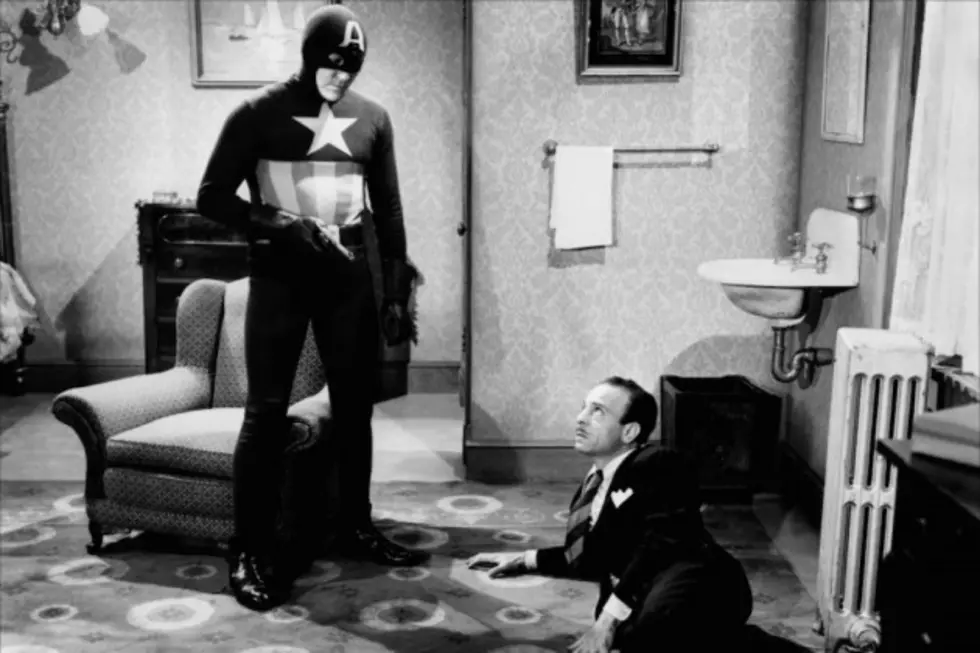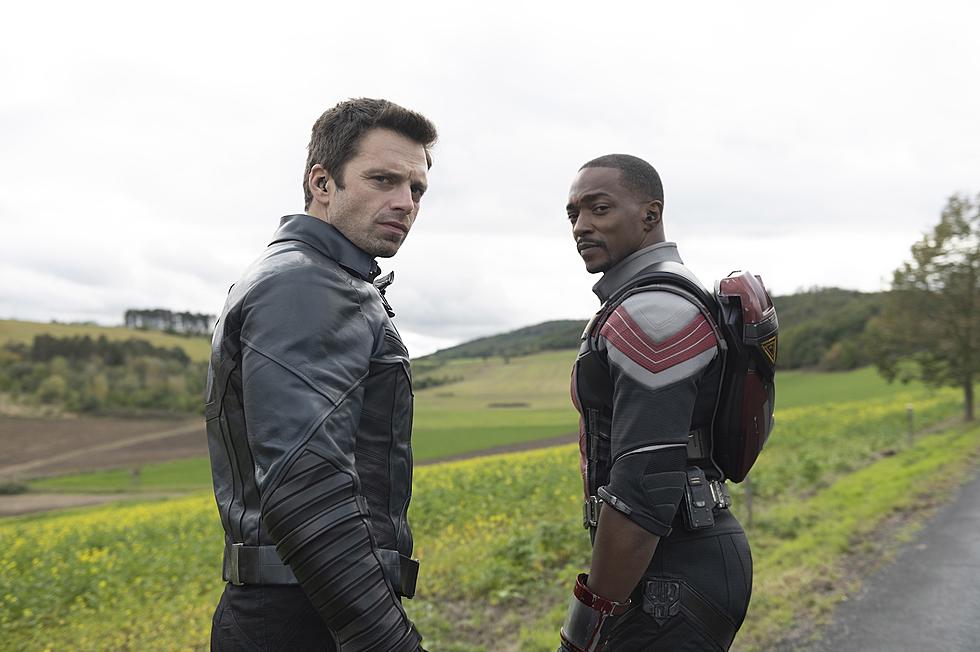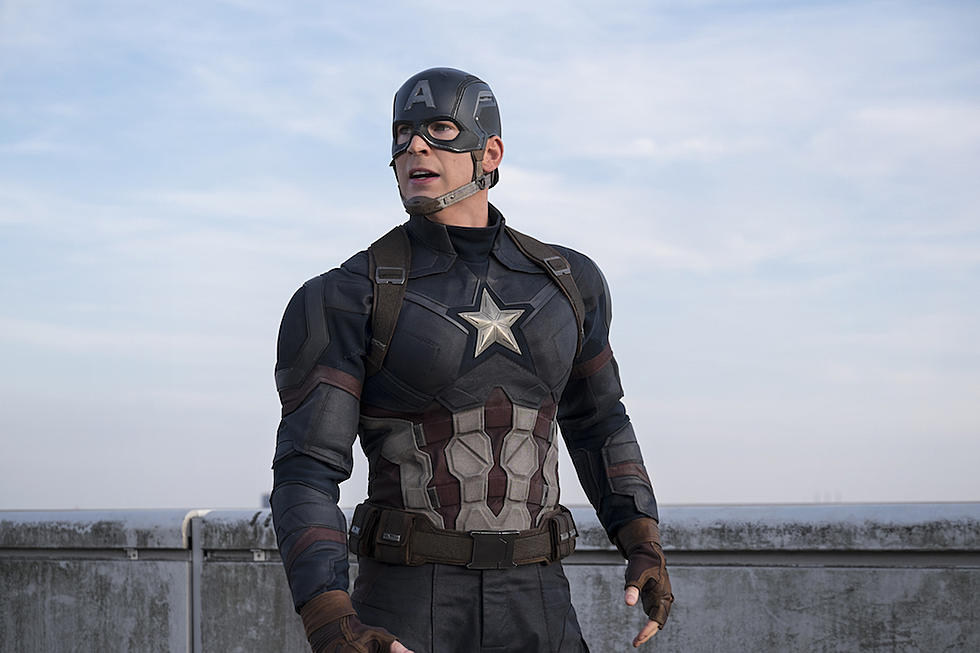
The Complete History of Comic-Book Movies, Chapter 4: ‘Captain America’
ScreenCrush editor, comic-book lover, and undiagnosed masochist Matt Singer is systematically watching every single (American) comic-book movie ever made in the order in which they were released. This week in The Complete History of Comic-Book Movies: Welcome to the prehistoric Marvel Cinematic Universe.
Captain America (1944)
Directors: Elmer Clifton and John English
Writers: Royal K. Cole, Ronald Davidson, Basil Dickey, Jesse Duffy, Harry L. Fraser, Grant Nelson, Joseph F. Poland
Starring: Dick Purcell, Lorna Gray, Lionel Atwill
Based on: Captain America, created by Joe Simon and Jack Kirby in Captain America Comics #1
Onscreen Iteration: First appearance
The Best and Worst Special Effects occur in the same scene. Captain America (Dick Purcell) follows the trail of his arch-nemesis, The Scarab (Lionel Atwill), to an apartment. As he arrives and announces himself, a thug inside opens fire. The camera cuts to the hallway, where his bullets splinter the door as Cap runs for cover. That’s a great moment, but it’s followed by the worst in the entire serial, when Cap responds by pulling his own gun and firing in the direction of the door handle. It looks like he misses his target by about four inches, but a half-second after he fires the handle pops off anyway, as if an off-screen production assistant yanked it with a string. It’s a real laugher. The rest of the fight that follows is pretty great, though.
Most Dated Moment: The Scarab spends most of Captain America either using or seeking out a variety of high-tech gadgets that will help him amass wealth and power. The first is a “thermodynamic vibration engine” that can topple skyscrapers—or as the characters repeatedly and hilariously call it, a vibrator. As in, “The vibrator! If it doesn’t shut off, the building will collapse!” According to Wikipedia (which is never wrong), vibrators predate this film by several decades, but they didn’t become widespread until the sexual revolution of the 1960s. It’s hard to imagine any movie made then or since that would let its primary villain say stuff like “I want to know more about the vibrator!” except maybe something directed by Mel Brooks.
Most Timeless Moment: Every serial so far has given its hero a female love interest, mostly to serve as a perpetual damsel in distress; Captain America’’s Gail Richards (Lorna Gray) is the first one with enough agency to be called a sidekick. She’s Captain America’s secretary in his day job as district attorney, but she’s also the only one who knows his secret identity, and she works with him to help foil The Scarab’s plots. She does occasionally require rescuing, but she’s also much more resourceful than any other woman in the serials I’ve watched so far. In Chapter 5, she’d rather die than talk to the Scarab’s goons, and in Chapter 3, Gail shoots and kills a guy who’s tailing Cap. At the end of the serial, after The Scarab’s been defeated and Captain America receives a commendation for bravery, he makes a point to thank Gail, saying that without her help none of his actions would have been possible, which is a cool moment as well. ‘Captain America’’s not exactly a feminist landmark, but it’s a step in the right direction—one that a lot of comic-book movies made decades later would have trouble matching.
Further Thoughts: The subtitle of Joe Johnston’s 2011 Captain America movie — The First Avenger — feels particularly appropriate in light of the fact that Cap was actually the first Marvel character to make it to the silver screen. His serial not only predates the Marvel Cinematic Universe by about 60 years, it predates Marvel period; in 1944, the company that published Captain America was still known as Timely Comics. Astonishingly, Cap was also the last Marvel character to star in a theatrically-released movie for more than 40 years, until 1986’s Howard the Duck.
The fact that Captain America preceded a four-decade big-screen drought for Marvel suggests it must have been an epic disaster, one bad enough to scare away Hollywood for a very long time. But that’s not true; this Cap certainly isn’t on par with the sensational Spy Smasher two years earlier, but it’s vastly superior to the boring, racist Batman serial from 1943. It’s a tad formulaic and repetitive, but it has its moments.
The most baffling part about it is the way it completely disregards Captain America’s origin story and mythology. This Cap dresses like the freedom-fighting patriot we all know and love, but the similarities to his comic-book counterpart basically end there. The serial’s Captain America isn’t Steve Rogers, he’s “Grant Gardner,” a crusading district attorney. No mention is made of his famous backstory involving Super-Soldier Serum or Nazi saboteurs; in fact, no mention is made of any backstory period. He also doesn’t seem to have any super-powers; his punches don’t pack any extra wallop and Dick Purcell looks more like the scrawny CGI pre-transformation Chris Evans than a man who’s been blasted with Vita-Rays.
Cap’s signature shield is a no-show too. Even though his discus-like weapon had been well-established in the Captain America comics for years, (and despite the fact that the film’s “Next Episode On...” title cards feature an image of Cap’s original pointy shield), the serial never introduces it; instead, Cap relies on his fists and an ordinary pistol to mete out justice. It’s honestly a bit of a letdown.
Given the fact that the very first issue of Captain America Comics from 1941 sported a cover that featured its title character socking Adolf Hitler in the jaw, it’s also disappointing that the ‘Cap’ serial is almost completely apolitical. The Batman serial turned the Dark Knight into a secret agent of the U.S. government; Captain America inexplicably avoids World War II entirely. Granted, it’s nice not to have to cringe at its hero spouting despicable racial epithets, but a serial that featured Cap actually beating the crap out of Hitler could have been amazing. Alas.
Instead, Cap battles The Scarab, whose insidious organization looks an awful lot like the one headed by The Scorpion in Adventures of Captain Marvel (none too coincidentally, both Captain serials were co-directed by John English). The set-up and plot mechanics are nearly identical; an archaeological expedition to an exotic foreign land returns with priceless artifacts and technology that one of its members wants for himself. In Captain Marvel, The Scorpion’s identity remains a mystery until the very last chapter; in Captain America, The Scarab is introduced as his alter ego, Dr. Maldor, right from the beginning, so the audience is ahead of the hero every step of the way. It’s a nice change of pace, but it also makes Cap look a little stupid. It takes him four hours to figure out what the viewer already knows.
In fairness, Dr. Maldor’s not exactly Einstein either. He doesn’t connect Captain America and Grant Gardner, and then he’s tricked by Gail Richards with a hilariously obvious ruse. In the serial’s final chapter, Maldor kidnaps Gail and demands the name of a doctor that’s coming to town to provide important medical help to a sick man. She gives him a fake name, Rodlam Baracs, which he immediately accepts at face value and passes along. A short while later, a man arrives at Grant Gardner’s office going by the name of Dr. Rodlam Baracs, and Cap immediately knows that Gail is in trouble. He also realizes Dr. Maldor is The Scarab, because Rodlam Baracs backwards is “Scarab Maldor.”
That’s a cool moment, except for one kind of enormous problem: Who the hell is named “Rodlam Baracs”? If you were an evil super-villain and a desperate woman gave you the name Rodlam Baracs in an attempt to stave off torture, would you buy it? Of course not, because you’re not a moron.
So Captain America isn’t the most clever serial, but it does have its fair share of hard-hitting action. There’s a nice variety of fight locations too; in Chapter 5, Cap breaks into a box factory. In Chapter 2, he dukes it out in a barn and one guy gets impaled by a pitchfork! Dick Purcell’s not the most dynamic action hero of the period, but he still commits pretty ferociously to all the punches, throws, and falls through breakaway furniture.
Sadly, Purcell died of a heart attack shortly after completing this serial at the age of 35. It was a tragic end for the man who originated the role of a nearly immortal hero (in the comics, Captain America’s died and come back to life at least three different times). Purcell’s Cap isn’t the strongest or most physically fit, but there’s something to be said for the human dimension he brought to the role. Today’s superheroes are incredible specimen and their movies look remarkable, but the men of these serials have a vulnerability missing from their modern counterparts. It’s easy for someone with the body of a demigod to put on spandex and fight crime. It takes a real man to do it with a beer gut.
The Captain America serial is currently available in its entirety on YouTube.
The Complete History of Comic-Book Movies Archive
More From ComicsAlliance










